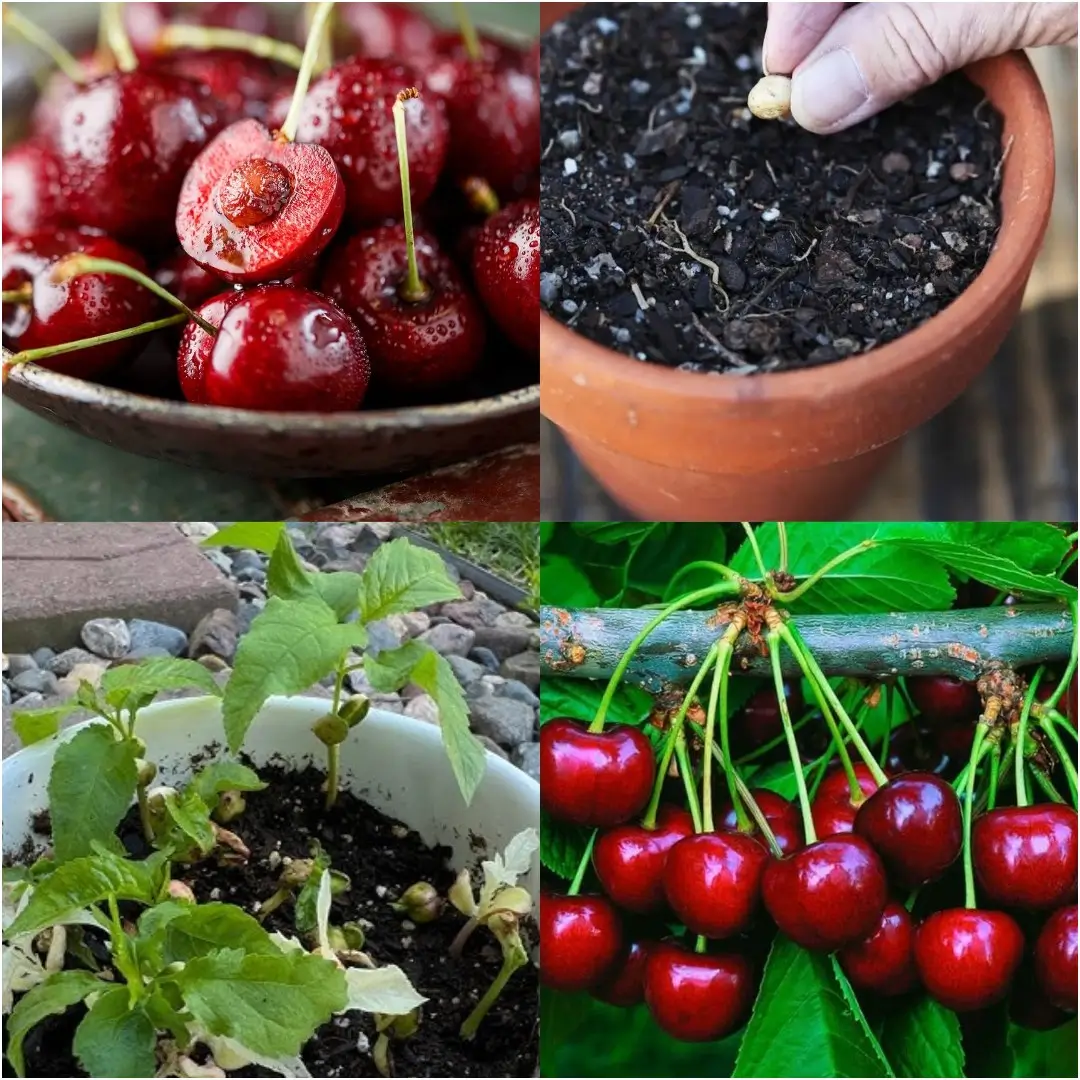If you’re wondering how to plant cherry seeds, growing cherry trees from seeds is not just a rewarding endeavor; it’s a delightful journey that allows me to connect with nature while enjoying the sweet fruits of my labor. In this guide, I’ll take you through the process of planting cherry seeds effectively, providing you with all the essential knowledge and tips needed to cultivate healthy cherry trees. Whether I’m drawn to the idea of showy, fragrant blossoms in the spring or the prospect of delicious fruits in late spring and early summer, I’m in for a treat as I learn how to plant cherry seeds and nurture them into flourishing trees!
While many backyard fruit growers opt to purchase young cherry trees from nurseries, growing cherry trees from fresh, local seeds offers a cost-effective and surprisingly easy alternative. You have two primary options for propagating cherry trees: prepare and plant seeds in the spring or direct sow them in the fall. With the right approach, you can germinate cherry seeds and nurture them into robust trees that will one day bear fruit. Just remember, it’s important to note that cherry trees of all kinds are toxic to humans and animals, so take care when handling them. Let’s dive into the world of cherry cultivation and explore the various aspects of this delightful gardening project!
Understanding Cherry Seeds: The Basics of Cherry Tree Types
When you embark on the journey of planting cherry seeds, the first step is selecting the right type of cherry. Understanding the differences between sweet cherries and sour cherries is crucial to your success.
Type of Cherry: Choosing the Right Variety
- Sweet Cherries (Prunus avium):
- These are the cherries you often find in desserts and fresh markets. They are known for their rich flavor and are generally grown in USDA zones 5-7 or 8-9 in the Pacific Northwest. Sweet cherries can grow tall, often reaching heights of over 35 feet.
- Sour Cherries (Prunus cerasus):
- Also known as tart or pie cherries, these are ideal for baking and cooking. They thrive in USDA zones 4-6 and typically grow up to 20 feet tall. If you live in a colder climate, sour cherries may be the better option for you.
Pollination Considerations
Not all cherry trees require a partner for pollination. If space is an issue, look into self-pollinating varieties like the semi-dwarf ‘Stella’ cherry tree, which can flourish on its own without needing another tree nearby. This makes it a great choice for small gardens or urban settings.
Local Cherries: The Key to Success
One of the essential tips for planting cherry seeds is to use fresh local cherries for your pits. Avoid supermarket cherries, as they may have been treated in ways that affect seed viability. Fresh, local cherries will adapt better to your growing conditions and ensure a healthier tree in the long run.
How to Plant Cherry Seeds in the Spring
If you’ve decided to plant cherry seeds in the spring, you’re in for a treat! Spring planting allows you to prepare your seeds effectively and gives them the best chance to thrive.
Prepare the Seeds for Planting
- Soak the Seeds:
- Begin by soaking your cherry seeds in warm water for a few minutes. This step helps soften the seed coat and can improve germination rates.
- Clean the Seeds:
- After soaking, gently clean the seeds to remove any lingering fruit pulp. This prevents mold and disease from affecting your seeds.
- Drying Process:
- Spread the cleaned seeds on a paper towel and let them dry for about five days in a warm area. Keeping them warm is crucial to maintaining their viability.
Stratification: Mimicking Winter Dormancy
To successfully germinate cherry seeds, you need to mimic the cold winter conditions they naturally experience. Here’s how to stratify your seeds:
- Storage:
- Place the dried seeds in a glass jar or a plastic container with a tight-fitting lid. This prevents moisture loss and keeps them safe during their cold storage.
- Refrigeration:
- Store the seeds in the refrigerator for ten weeks. Mark the date on your calendar to ensure you don’t forget about them. This cold treatment is crucial for breaking the seeds’ dormancy.
Planting Your Cherry Seeds
After the ten-week stratification period, it’s time to plant those seeds!
- Room Temperature:
- Before planting, allow the seeds to come to room temperature, which usually takes about three hours. This helps reduce shock when they’re planted.
- Container Planting:
- Fill a small container with potting soil and plant 2-3 seeds per container. Ensure the soil is well-draining and keep the container in a sunny spot.
- Watering:
- Water the seeds carefully, ensuring the soil remains moist but not soggy. Consistent moisture is vital for germination.
- Thinning Seedlings:
- Once the seedlings reach about 2 inches tall, thin them out to retain the strongest plants. This step ensures that your cherry trees will have enough space to grow without competing for resources.
- Transplanting Outdoors:
- After the last frost has passed and the seedlings have grown a few inches taller, you can transplant them outdoors. Choose a sunny spot with well-drained soil for their new home.
How to Plant Cherry Seeds in the Fall
If you prefer a more straightforward approach, you can also plant cherry seeds directly in the fall. This method allows nature to handle the cold stratification process for you.
Direct Sowing: A Simple Method
- Cleaning and Drying:
- Clean and dry the cherry seeds as you would for spring planting. This step is important to ensure that the seeds are free of any contaminants.
- Choosing the Right Spot:
- Select a protected garden area where the seeds will be safe from harsh winds and foot traffic. A spot with full sun and well-draining sandy soil is ideal.
- Planting Depth:
- Plant the seeds about 1 inch deep in the topsoil. Water the area thoroughly after planting to promote good seed-to-soil contact.
- Monitoring for Emergence:
- Keep an eye on your garden spot for seedling emergence in the spring. It might take a little longer compared to spring planting, but nature will work its magic!
- Transplanting:
- Once the seedlings reach about 10-12 inches tall, you can transplant them to their permanent location. This could be your garden or another suitable area.
Protecting Your Cherry Trees from Wildlife
Cherry trees can attract various wildlife, and unfortunately, young trees can be at risk from deer and other animals that enjoy munching on tender plants. Here’s how to protect your precious cherry trees:
Winter Protection
- Burlap Wrapping:
- Wrap your young trees loosely in burlap during mid to late autumn. Deer are often deterred by burlap, and it allows sunlight and rain to nourish the tree.
- Annual Protection:
- Consider wrapping the trees for the first two to three years to safeguard the bark. Young trees are particularly vulnerable, especially during lean winters when food is scarce.
Growth Expectations: Patience Pays Off
Now that you’ve planted your cherry seeds, how long until you can savor those delicious fruits? Expect your cherry trees to start bearing fruit anywhere from three to ten years, depending on the variety you chose. Patience is key! In the meantime, learn about pruning and caring for your cherry trees to ensure they grow strong and healthy.
Additional Tip for Faster Fruiting
If you want to expedite the fruiting process, consider grafting a cherry seedling onto existing stock. This advanced technique can help you enjoy cherries sooner, but it requires some gardening skill and knowledge.
Your Cherry-Planting Adventure Awaits!
In conclusion, knowing how to plant cherry seeds opens the door to a rewarding gardening experience. Whether you choose to plant in spring or fall, each method has its unique benefits. From selecting the right cherry type to protecting your trees from wildlife, you now have all the tools to grow healthy cherry trees in your garden.
So gather those cherry seeds, get your hands dirty, and enjoy the process of nurturing these beautiful trees. With a little patience and care, you’ll be rewarded with delightful blossoms and, eventually, a bountiful harvest of cherries! Happy gardening!
FAQs
Can you plant the seed from a cherry?
Yes, you can plant the seed from a cherry! However, it’s essential to use seeds from fresh, local cherries rather than supermarket cherries, as the latter may not be viable. Planting the seeds from ripe cherries can lead to successful germination and growth of your cherry tree.
How long do cherry seeds take to germinate?
Cherry seeds typically take about 2 to 3 weeks to germinate once they are properly prepared and planted. However, keep in mind that the germination process can be influenced by various factors, such as temperature and moisture levels.
How do you seed cherries?
To seed cherries, first, you need to remove the pit from the cherry fruit. Cut the cherry in half and carefully extract the pit. Afterward, you can clean the seed by rinsing it under warm water to remove any fruit residue. Once cleaned, you can follow the germination process outlined in this guide.
How do you start ground cherry seeds?
Starting ground cherry seeds involves a similar process to cherry seeds. Begin by planting the seeds indoors about 6 to 8 weeks before the last frost date. Sow the seeds in seed-starting mix, covering them lightly with soil. Keep the soil moist and provide warmth and light. Ground cherry seeds usually germinate within 10 to 14 days.


